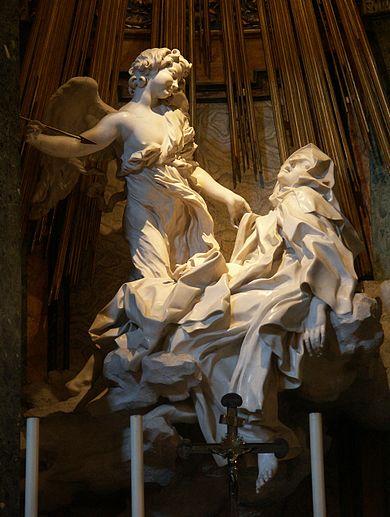
Baroque sculpture is the sculpture associated with the Baroque style of the period between the early 17th and mid 18th centuries. In Baroque sculpture, groups of figures assumed new importance, and there was a dynamic movement and energy of human forms—they spiralled around an empty central vortex, or reached outwards into the surrounding space. Baroque sculpture often had multiple ideal viewing angles, and reflected a general continuation of the Renaissance move away from the relief to sculpture created in the round, and designed to be placed in the middle of a large space—elaborate fountains such as Gian Lorenzo Bernini‘s Fontana dei Quattro Fiumi (Rome, 1651), or those in the Gardens of Versailles were a Baroque speciality. The Baroque style was perfectly suited to sculpture, with Bernini the dominating figure of the age in works such as The Ecstasy of St Theresa (1647–1652).[1] Much Baroque sculpture added extra-sculptural elements, for example, concealed lighting, or water fountains, or fused sculpture and architecture to create a transformative experience for the viewer. Artists saw themselves as in the classical tradition, but admired Hellenistic and later Roman sculpture, rather than that of the more “Classical” periods as they are seen today.[2]
Baroque sculpture followed Renaissance and Mannerist sculpture and was succeeded by Rococo and Neoclassical Sculpture. Rome was the earliest centre where the style was formed. The style spread to the rest of Europe, and especially France gave a new direction in the late 17th century. Eventually it spread beyond Europe to the colonial possessions of the European powers, especially in Latin America and the Philippines.
The Protestant Reformation had brought an almost total stop to religious sculpture in much of Northern Europe, and though secular sculpture, especially for portrait busts and tomb monuments, continued, the Dutch Golden Age has no significant sculptural component outside goldsmithing.[3] Partly in direct reaction, sculpture was as prominent in Catholicism as in the late Middle Ages. The Catholic Southern Netherlands saw a flourishing of Baroque sculpture starting from the second half of the 17th century with many local workshops producing a wide range of Baroque sculpture including church furniture, funeral monuments and small-scale sculptures executed in ivory and durable woods such as boxwood. Flemish sculptors would play a prominent role in spreading the Baroque idiom abroad including in the Dutch Republic, Italy, England, Sweden and France.[4]
In the 18th century much sculpture continued on Baroque lines—the Trevi Fountain was only completed in 1762. The Rococo style was better suited to smaller works.[5]
Contents
1 Origins and Characteristics
2 Bernini and Roman Baroque sculpture
2.1 Maderno, Mochi, and the other Italian Baroque sculptors
3 France
4 The Southern Netherlands
5 The Dutch Republic
6 England
7 Germany and the Habsburg Empire
8 Spain
9 Latin America
10 Notes
11 Bibliography
Post time: Aug-03-2022
